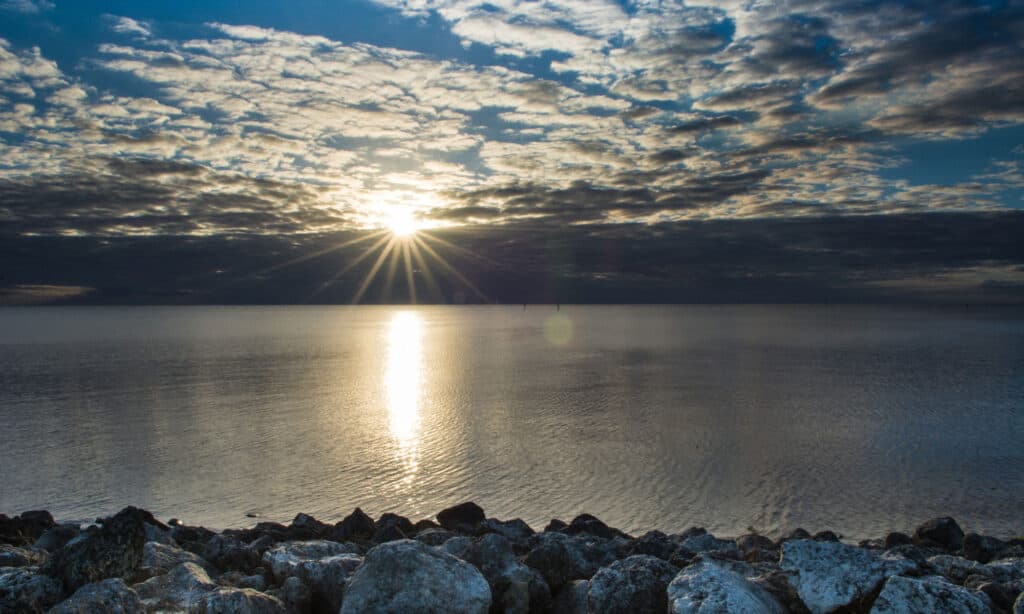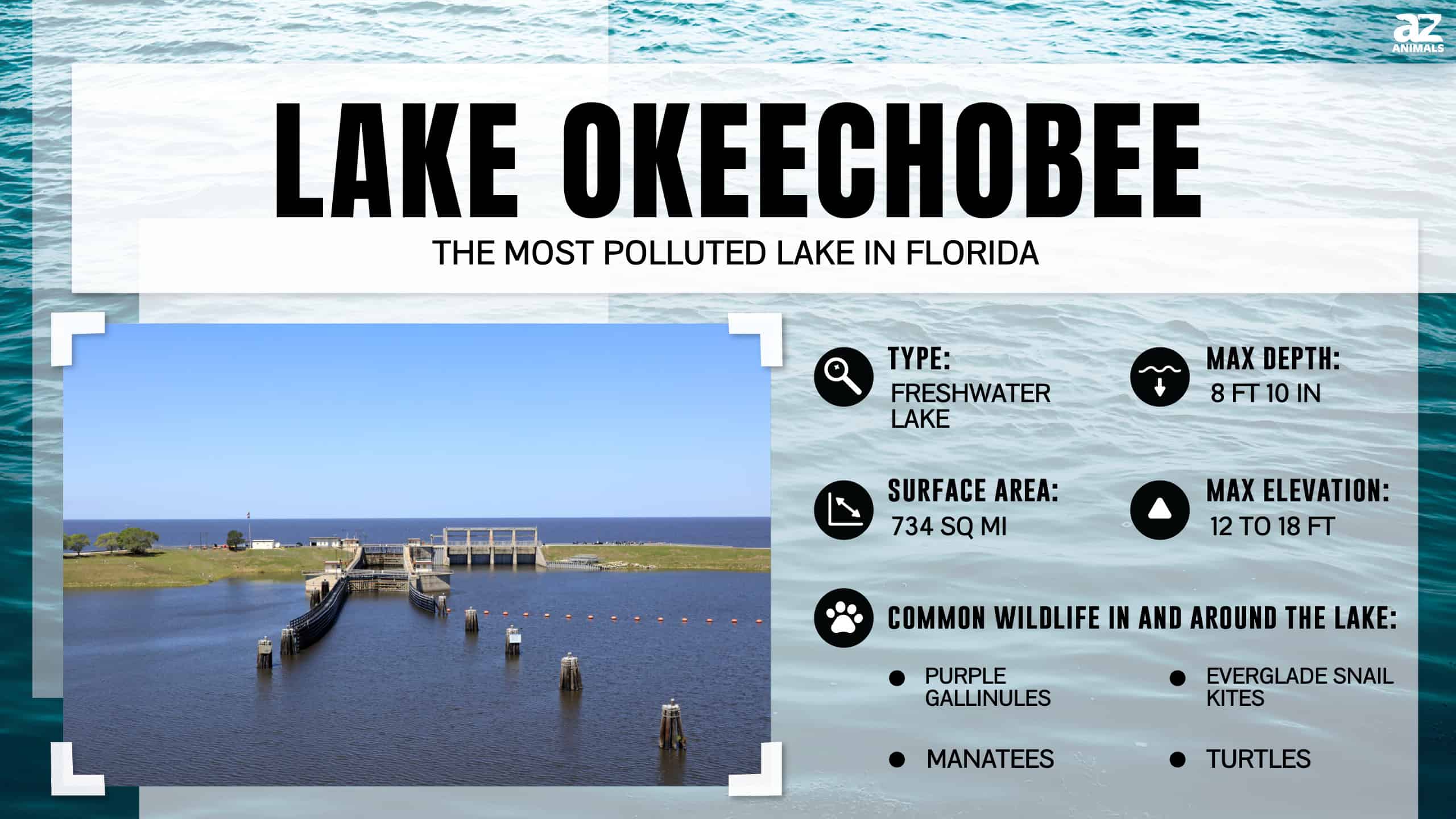Florida is the ultimate vacation destination. It features pristine beaches, wetlands, and endless fun activities. Most visitors are in awe of its natural tropical beauty and warm waters. But what you may not realize is that Florida has some of the most polluted freshwater in the world.
The state features nearly 900,000 acres unsafe for swimming and unhealthy for supporting aquatic life. Several lakes in the region are unusable, period.
The Everglades, a 1.5-million-acre wetland preserve, contains dirty stormwater and toxic algae. And one lake, in particular, is harmful to humans and animals.
Discover the most polluted lake in Florida, including the animals that live within it and what could potentially clean it up.
What is the Most Polluted Lake in Florida?

The most polluted lake in Florida is Lake Okeechobee. It features high levels of toxic algae and agricultural runoff.
©Allison Michael/Shutterstock.com
Lake Okeechobee is the most polluted lake in Florida.
Nicknamed “Florida’s inland sea,” Lake Okeechobee is the largest freshwater lake in Florida. It is a shallow lake with an impressive size of 734 square miles. Standing on its shores gives you the impression of an ocean because it’s too big to see across. It is the second-largest freshwater lake within the contiguous United States, right behind Lake Michigan. The lake sits within five counties in South-Central Florida, with the Kissimmee River to the north, which is Lake Okeechobee’s main source.
The lake has had an onslaught of environmental concerns, with the most recent dating from 2007 to the present.

Where is Florida’s Most Polluted Lake Located on a Map?
Lake Okeechobee is located near Florida’s eastern coastline – about an hour west of Palm Beach. It is situated to the west of the JW Corbett Wildlife Management Area. The Atlantic coastal towns of Port St. Lucie and Jupiter are also close to Lake Okeechobee.
Why Does It Have Such a High Level of Pollution?
Over the last few decades, Lake Okeechobee has had large amounts of pollution primarily from stormwater and agricultural runoff. Tropical storms cause flooding from nearby tributaries, rivers, and estuaries, which includes runoff and pollution.
The lake frequently experiences algal blooms. These rapid growths of microscopic algae and bacteria create a colorful scum on the water’s surface, which can be harmful to humans and animals. Toxic blooms can occur when nutrients from farmlands and lawns feed the algae that exist in the lake, causing a toxic bacterial bloom.
There is also a lot of red tape when it comes to preventing pollution and cleaning up a state’s freshwater source.
What Can Reduce the Pollution?
There are laws and measures in place to limit and prevent pollution in the state’s freshwater. However, many of them are not properly enforced. The Florida Department of Agriculture and the Department of Environmental Protection seem to always be understaffed. There are pollution limits for agricultural runoff and promises of reform and increased inspections. But despite an increase in noncompliance, there has been little enforcement.
Florida’s governor, Ron Desantis, has made efforts to clean up the toxic algae by creating the Blue-Green Task Force. The task force recommends strategies to combat the toxic blooms, including investing in innovative technologies that detect and prevent harmful algae. However, the task force has recently criticized lawmakers for not taking action on their recommendations.
Types of Animals in Lake Okeechobee: The Most Polluted Lake in Florida

Lake Okeechobee is also one of the most alligator-infested lakes in the country.
©Sorbis/Shutterstock.com
Despite the water’s harmful pollution levels, there are still many wildlife species that live in and around Lake Okeechobee. In fact, the lake is one of the most alligator-infested waters in the state.
You will find fish, such as sunfish, largemouth bass, bluegills, and black crappie. Many people still fish from the lake. But you should always follow state guidelines and health alerts before consuming fish in Lake Okeechobee.
Other animals in or near the lake include:
- Manatees
- Many birds (Everglade snail kites, purple gallinules, herons, etc.)
- Frogs and toads
- Snakes
- Turtles
- Bobcats
- Lizards
How Does Lake Pollution Affect Wildlife?
Water pollution can affect an animal’s ability to grow and reproduce. It can also damage parts of their bodies, affect their digestion, and make it harder for them to swim.
Toxic algae blooms can be toxic and deadly to animals, such as fish, birds, and manatees. They can also be harmful to humans, causing skin rashes and gastrointestinal issues, such as stomach pain, nausea, diarrhea, and vomiting. Some people also experience respiratory symptoms, like trouble breathing.
While swimming is still allowed in Lake Okeechobee, you should use extreme caution when entering the water. Follow all guidelines and pay attention to warning signs posted along the banks. Not only can the water make you ill, but the many alligators that infest the lake can be dangerous.
Check out this article about the ten most polluted lakes in the United States.
The photo featured at the top of this post is © NASA, Public domain, via Wikimedia Commons – License / Original
Thank you for reading! Have some feedback for us? Contact the AZ Animals editorial team.






